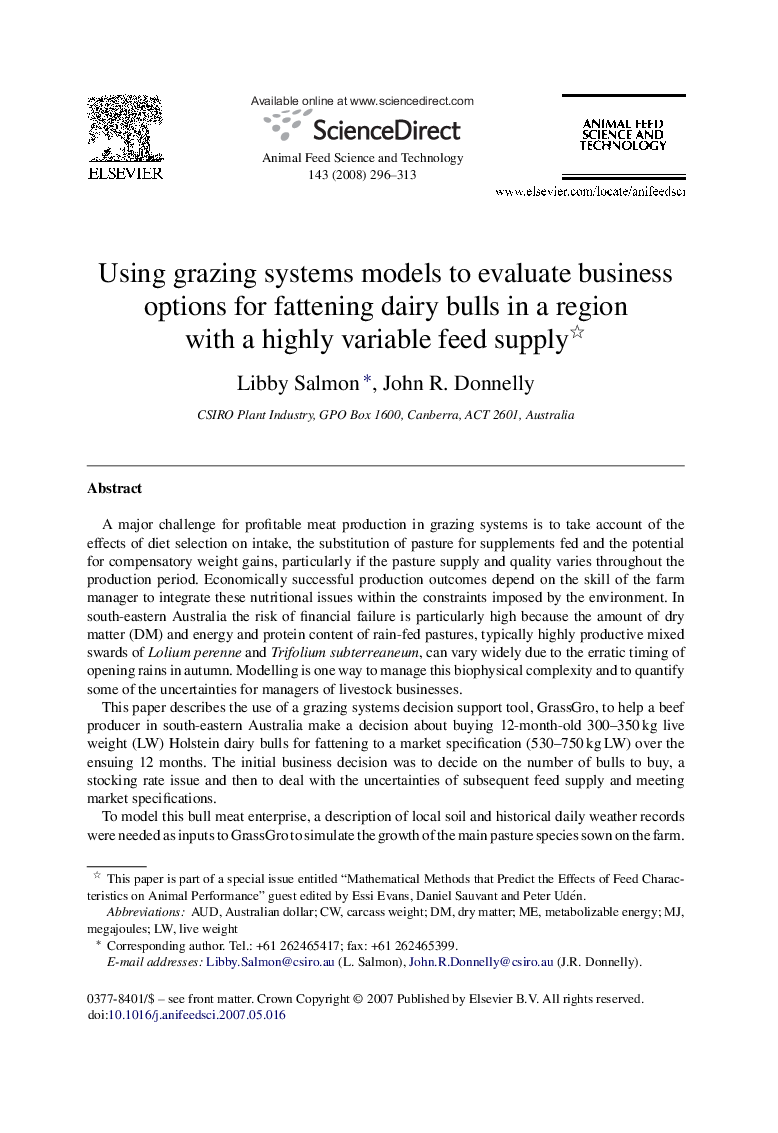| کد مقاله | کد نشریه | سال انتشار | مقاله انگلیسی | نسخه تمام متن |
|---|---|---|---|---|
| 2420560 | 1552470 | 2008 | 18 صفحه PDF | دانلود رایگان |

A major challenge for profitable meat production in grazing systems is to take account of the effects of diet selection on intake, the substitution of pasture for supplements fed and the potential for compensatory weight gains, particularly if the pasture supply and quality varies throughout the production period. Economically successful production outcomes depend on the skill of the farm manager to integrate these nutritional issues within the constraints imposed by the environment. In south-eastern Australia the risk of financial failure is particularly high because the amount of dry matter (DM) and energy and protein content of rain-fed pastures, typically highly productive mixed swards of Lolium perenne and Trifolium subterreaneum, can vary widely due to the erratic timing of opening rains in autumn. Modelling is one way to manage this biophysical complexity and to quantify some of the uncertainties for managers of livestock businesses.This paper describes the use of a grazing systems decision support tool, GrassGro, to help a beef producer in south-eastern Australia make a decision about buying 12-month-old 300–350 kg live weight (LW) Holstein dairy bulls for fattening to a market specification (530–750 kg LW) over the ensuing 12 months. The initial business decision was to decide on the number of bulls to buy, a stocking rate issue and then to deal with the uncertainties of subsequent feed supply and meeting market specifications.To model this bull meat enterprise, a description of local soil and historical daily weather records were needed as inputs to GrassGro to simulate the growth of the main pasture species sown on the farm. GrassGro then computed the daily dry matter (DM) intake and weight gain of the bulls based on their metabolizable energy (ME) and protein requirements, which were specific for their genotype, maturity level, live weight and body condition. GrassGro includes models of diet selection and substitution, and the simulation of compensatory weight gain in making these assessments. Gross margin analysis that used this information from the simulations showed that the bull beef enterprise was potentially highly profitable but it also carried high risks of financial loss if the start of the pasture-growing season was delayed. These production and economic outcomes were very sensitive to stocking rate, so the number of bulls purchased was a key decision for financial success.In this environment, the best financial outcome was achieved when 2.5 bulls/ha were purchased. Sensitivity analysis using GrassGro showed that purchase of similar numbers of younger, lighter bulls (2.5–3.5 bulls/ha) increased the mean gross margin by up to AUD$600 /ha, despite a higher risk of failure to achieve the target weight.
Journal: Animal Feed Science and Technology - Volume 143, Issues 1–4, 22 May 2008, Pages 296–313